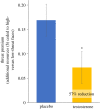Testosterone reduces the threat premium in competitive resource division
- PMID: 31138068
- PMCID: PMC6545090
- DOI: 10.1098/rspb.2019.0720
Testosterone reduces the threat premium in competitive resource division
Abstract
Like other animals, humans are sensitive to facial cues of threat. Recent evidence suggests that we use this information to dynamically calibrate competitive decision-making over resources, ceding more to high-threat individuals (who appear more willing/able to retaliate) and keeping more from low-threat individuals. Little is known, however, about the biological factors that support such threat assessment and decision-making systems. In a pre-registered, double-blind, placebo-controlled, cross-over testosterone administration study ( n = 118 men), we show for the first time that testosterone reduces the effects of threat on decision-making: participants ceded more resources to high-threat (versus low-threat) individuals (replicating the 'threat premium'), but this effect was blunted by testosterone, which selectively reduced the amount of resources ceded to those highest in threat. Thus, our findings suggest that testosterone influences competitive decision-making by recalibrating the integration of threat into the decision-making process.
Keywords: bargaining; contest; dominance; signalling; social perception.
Conflict of interest statement
We declare we have no competing interests.
Figures




References
-
- Arnott G, Elwood RW. 2009. Assessment of fighting ability in animal contests. Anim. Behav. 77, 991–1004. (10.1016/j.anbehav.2009.02.010) - DOI
Publication types
MeSH terms
Substances
Associated data
LinkOut - more resources
Full Text Sources
Other Literature Sources
